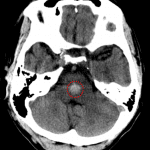

azotemia with renal thrombosis, dyspnea with pulmonary thromboembolism. Indeed, thrombosis may only manifest as developing or worsening organ function, e.g. Unfortunately, thrombosis is very difficult to diagnosis based on current laboratory or imaging modalities. Thrombosis can be more clinically important than hemorrhage because it causes hypoxic injury to vital organs (liver, kidney) and can result in organ dysfunction, failure and even death. Severe defects in primary hemostasis can result in intra-cavity hemorrhage and hematomas, just like secondary hemostatic disorders.

The severity of the defect also affects the type of hemorrhage that occurs. Secondary hemostasis: Typical signs are ecchymoses, hematomas and bleeding into body cavities, including joints.Other sources use it to define hemorrhages that are a size between petechiae (1 cm), e.g. Some medical dictionaries use it as a generic term to encompass petechiae and ecchymoses. Also, the definition of purpura varies depending on who you read. Primary hemostasis: Typical signs are hemorrhage from mucosal surfaces (epistaxis, hematuria, melena), petechiae (pinpoint hemorrhages), purpura (larger than petechiae) and ecchymoses (bruise or larger areas of hemorrhage).

In animals that present with excessive hemorrhage, the site and nature of the hemorrhage can be helpful in determining which hemostatic pathway is defective. Hemorrhageĭisorders in primary and secondary hemostasis and accelerated fibrinolysis can result in excessive hemorrhage. Certain breeds are known to have inherited defects in hemostasis and this should be considered in a young animal with clinical signs suggestive of a hemostatic disorder. Recurrent clinical signs, particularly in a young animal, are highly suggestive of an inherited defect whereas a sudden onset in an older animal is more likely to be secondary to an acquired defect, associated with underlying disease or drug administration. Historical details and signalment are important when evaluating an animal with a suspected hemostatic disorder. furuncles d.Hemostatic disorders usually manifest as excessive hemorrhage in animals, however certain hemostatic disorders, such as disseminated intravascular coagulation (DIC), are characterized by thrombosis more than hemorrhage, particularly in horses and cats. scabies Which lesions are large, tender, swollen areas caused by staphylococcal infection around hair follicles?ĭ.
#Pinpoint hemorrhages skin#
True Many of the children in the Happy Hours Day Care Center required treatment for.a skin infection caused by an infestation of itch mites. nevus (T/F)A biopsy is the removal of a small piece of living tissue for examination. is a small, dark, skin growth that develops from melanocytes in the skin. koilonychia (T/F)Botox injections permanently remove frown lines. This condition is also called spoon nail. True The medical term referring to a malformation of the nail is. albinism (T/F)Anhidrosis is the abnormal condition of lacking sweat in response to heat. This disorder, which is known as.is due to a missing enzyme necessary for the production of melanin. hematoma Trisha Bell fell off her bicycle and scraped off the superficial layers of skin on her knees. True Soon after Ying Li hit his thumb with a hammer, a collection of blood formed beneath the nail. False Clue: the presence of excessive body and facial hair in women hirsut -ism (T/F)A cyst is an abnormal sac containing gas, fluid, or a semisolid material. (T/F)Folliculitis is an autoimmune disorder that attacks the hair follicles.


 0 kommentar(er)
0 kommentar(er)
